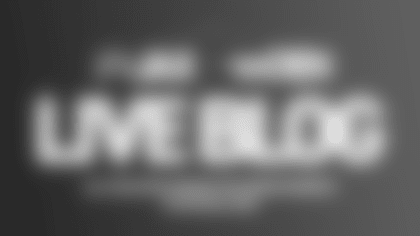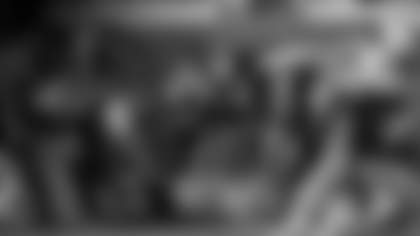Join Jaguars Inside Report Senior Editor Vic Ketchman as he tackles the fans' tough questions.
Scot from Jacksonville:
OK, so you like Hall the CB with number nine, and it's tough to argue with your logic if he really is that type of player. Can you analyze past top 15 DB picks?
Vic: 1995—none; 1996—Alex Molden, Walt Harris; 1997—Shawn Springs, Bryant Westbrook, Tom Knight, Michael Booker; 1998—Charles Woodson, Duane Starks; 1999—Champ Bailey, Chris McAlister; 2000—Deltha O'Neal; 2001—none; 2002—Quentin Jammer, Roy Williams; 2003—Terence Newman, Marcus Trufant. Good cornerbacks are tough to find, aren't they? All of a sudden, Fernando Bryant looks pretty good.
Dan from Ohio:
If a high school player enters the draft and is serious about it, will NFL scouts actually look at him and, if so, does he have a chance of getting drafted?
Vic: Sure they'll look at him, but this is not the National Ballerina Association. This is a violent game played by men at the peak of their physical development. I can't imagine an 18-year-old being able to compete physically in the NFL. Great college players have difficulty making the transition. What chance would a kid coming out of high school have?
Malosi from Valencia, CA:
How many draft choices do we have this year and in what rounds do they fall?
Vic: The Jaguars have one pick in each of the draft's seven rounds, and an extra pick in the third round. They might also receive a compensatory pick – probably in the seventh round – when the league announces those.
Rob from St. Augustine, FL:
How does weak and strong-side linebacker relate to left and right outside?
Vic: Weak-side and strong-side linebackers are determined by the offensive formation. Usually, the offensive formation is considered to be strong (more guys to the right or left of the ball) to the side of the tight end. The strong-side linebacker is usually aligned opposite the tight end and is often used in pass-coverage against the tight end. The strong-side linebacker is usually an athletic guy who plays well in space. The weak-side linebacker is more of a forward-moving player. He takes on blocks, chases down plays from behind and is generally regarded to be more of an inside linebacker. He is deployed to the side of the field opposite the strength of the offensive formation – the weak side – which, in most cases, would be the side of the field opposite the tight end.
Grant from Manchester, England:
I have a couple of questions regarding the salary cap. The Jaguars have 67 players contracted; do they all count against the cap? What's the maximum number of active players a team can have on game day? Do players on injured reserve count against the salary cap?
Vic: At this time of the year, a team's salary cap includes the top 51 salaries and all of their other monies (amortization, likely-to-be-earned incentives, etc.), and all of the monies except salary for the players from 52 and up. On game day, a team may activate 45 players and a "third quarterback." Players on injured reserve count against the cap.
Keith from Millington, TN:
Vic, about your post on Boulware; why would he or a linebacker his size need to be in a 3-4 defense? You said he may require more open space, but doesn't he have to take on more OL than the 4-3 LBs, because the 4-3 tackles take up more space? I would think the 4-3 LBs have it easier than the 3-4 LBs with space.
Vic: The whole idea of playing the 3-4 is to feature the linebacker position. Teams that play the 3-4 use their linebackers more creatively. One of those linebackers in particular, often the second inside guy, is used much like a "hero" or "monster" back is used on a college defense. He is often used as a run-around guy whose speed and athletic ability allow him to be featured in a play-maker role. The 4-3 doesn't have that extra position, though the weak-side linebacker position is sometimes used that way. Linebackers in a 4-3 defense usually have very specific responsibilities. Michael Boulware would certainly be a candidate to play strong-side linebacker in any defensive alignment, because his pass-coverage skills are so strong, but 3-4 coaches probably see a role beyond pass-coverage. They see Boulware's speed and athletic ability and probably think of using Boulware in that "extra" role. They probably envision featuring Boulware as a play-maker. It's no coincidence Bill Cowher was in attendance at Florida State's pro-day workouts. Last year, Cowher drafted Florida State's Alonzo Jackson in the second round, for the purpose of making Jackson a "featured" linebacker. Teams such as the Steelers who play the 3-4 are always looking for fast and athletic linebackers who might become play-makers. It's the basis for playing the 3-4. Your linebackers must make plays because the defensive linemen are used solely to occupy the blockers.
Alan from Jacksonville:
I found the article where I first read about the best-available Gator-Seminole-Hurricane strategy. There are some interesting choices the Jags could have made in the first round: Tony Boselli vs. Warren Sapp (1995), Kevin Hardy vs. Ray Lewis (1996), R.J. Soward vs. Laveranues Coles (2000).
Vic: How about Rashean Mathis vs. Taylor Jacobs (2003)? Marcus Stroud vs. Kenyatta Walker (2001)? It's the NATIONAL Football League, Alan.
John from Orange Park, FL:
I think your theory of roster construction through the draft is no better illustrated then the Jags offensive line. There are three second-rounders and one third-rounder on the line, which just so happens to be the strength of our team. With that having been said, I assume you approve of the free agency work to date?
Vic: Yeah, I like what the Jaguars have done in free agency because, at all times, their priority has been maintaining a healthy salary cap. Some of those acquisitions are going to be mistakes, because you're always going to have a percentage of failure in all personnel decisions, but the Jaguars' cap will not be held hostage or suffer dramatically from anything it's done in this free-agency period. It's obvious the Jaguars used free agency to complement the draft, and with continued success in the draft the Jaguars won't have to rely as heavily on free agency in future years as they did this year. That's the next step in roster-building for this team.













